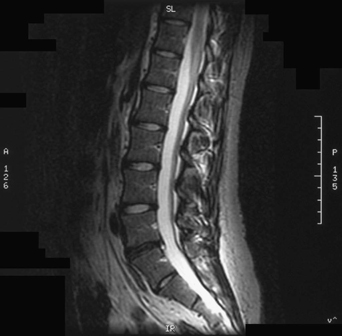39 A 39-year-old man had low back pain that was refractory to months of conservative therapy. The pain has altered his lifestyle. Lumbar magnetic resonance imaging (MRI) (sagittal T2-weighted) demonstrates an L4–L5 annular tear without other evidence of significant degenerative change (Fig. 39-1). Note the hyperintensity of the dorsal annulus. FIGURE 39-1 L4–L5 annular tear as seen on sagittal MRI of the lumbar spine. Annular tear This patient is a candidate for artificial disc implantation. Degenerative lumbar disc disease is prevalent in the middle-aged population. It is estimated that over 60 million Americans suffer lower back pain every year. Multiple treatments have been tried over the years for mechanical lower back pain secondary to degenerative disc disease (DDD). They range from facet rhizotomy, to indradiscal electrothermal therapy (IDET), and ultimately, to spinal fusion. It is estimated that about one quarter million people undergo fusion surgery every year in the United States alone. Lumbar artificial discs have emerged as an alternative technique to relieve pain while preserving the motion segment. The artificial discs offer restoration of forami-nal and disc heights and the reestablishment of normal lordotic curvature. These factors seem to contribute to a lesser occurrence of adjacent level disease sometimes seen with arthrodesis. The U.S. Food and Drug Administration has recently approved the Charité artificial disc (DePuy Spine, Raynham, Massachusetts). This is the first device for spinal disc replacement in the United States. The Charité artificial disc is indicated for spinal arthro-plasty in patients age 18 to 60 years, with adequate bone quality. Candidates should present with clinical and radiographic findings of single-level DDD between L4 and S1.A 6-month trial of conservative therapy is needed prior to consideration for disc replacement surgery. An MRI of the lumbar spine, flexion and extension lumbar x-rays, a full-length standing film to rule out scoliosis or other major spine deformity, and a dual energy x-ray absorptiometry (DEXA) scan are part of the preoperative workup. Contraindications are end-plate compromise (a vertebral body burst fracture or osteoporosis) or conditions that may compromise bone density (chronic anticonvulsant use, low estrogen levels). Surgery is not offered if the patient’s bone mineral density is more than one standard deviation below the norm. Absolute contraindications are the presence of an uncontained disc herniation with or without radiculopathy, spinal canal or lateral recess stenosis, translational instability over 3 mm, spondylolysis, isthmic spondylolisthesis, and advanced facet disease or scoliosis. The implantation utilizes a retroperitoneal approach, done in conjunction with a vascular or general surgeon and a spine surgeon. Patients with morbid obesity or multiple previous abdominal surgeries pose significant technical challenges and should be excluded. Pregnancy and infection are obvious contraindications as well. In a prospective randomized study looking at neurologic complications and outcome following anterior lumbar interbody arthrodesis versus lumbar arthroplasty, the number of patients with major, minor, or other neurologic complications was equivalent. The Charité disc recipients had equivalent or better mean self-reported assessments when compared with the fusion patients. Geisler FH, Blumenthal SL, Guyer RD, et al. Neurological complications of lumbar artificial disc replacement and comparison of clinical results with those related to lumbar arthrodesis in the literature: results of multicenter, prospective, randomized investigational device exemption study of Charité intervertebral disc. J Neurosurg Spine 2004;1:143–154 Griffith SL, Shelokov AP, Buttner-Janz K, LeMaire JP, Zeegers WS. A multicenter retrospective study of the clinical results of the LINK SB Charité intervertebral prosthesis. The initial European experience. Spine 1994;19:1842–1849
Motion Preservation Technology
Presentation
Radiologic Findings

Diagnosis
Treatment
Discussion
SUGGESTED READING
< div class='tao-gold-member'>
Motion Preservation Technology
Only gold members can continue reading. Log In or Register to continue

Full access? Get Clinical Tree








